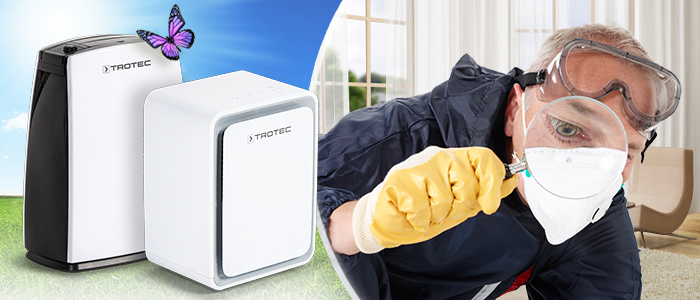It is now time to get rid of a nasty legacy of the wet, cold season. For it is during the winter that flats and houses often suffer from damp and outbreaks of mildew which can be unhealthy. Ideally, it is best to attack it when it is initially attempting to take hold. Which is why the experts recommend a thorough spring checkup. And, of course, we have to be involved – it’s a point of honour!
A light field pack is good enough: and a torch would be ideal to enable you to investigate those dark, hidden corners. If we encounter tough supply problems, we just take a break from going through the house, or flat, and withdraw to the kitchen for a quick snack. So, let’s get going and let’s stick together!
We begin by checking the insides of the windows.
Moisture always builds up where it is coldest. So mildew is very quick to settle in the corners of windows in older buildings or, more generally, where windows have poor insulation.
We look critically at radiator niches.
The outer walls are thinner there, so they also cool down more quickly than elsewhere. As long as the radiators are switched on, there is no problem. But there is a risk of mildew when the heating is not fully on or if it is switched off.
Now we check the corners of all the rooms and ceilings.
Since outer walls get very cold during the winter, condensation is prone to accumulate and cause build-ups of mould patches. This applies particularly, of course, to angled or hidden corners, for example in thebasement. A good job we’ve brought a torch!
We need to check behind the furniture too.
Is the air free to circulate behind your cupboards so that any condensate can escape? If not, mildew will find this the ideal breeding ground, especially if the back of the cupboard is also dusty. Furniture is best moved about 4 to 6 inches from the wall and it should be dusted regularly.
We make a thorough inspection of the kitchen and bathroom.
This is where most damp usually builds up, and only regular airings or an air dehumidifier will help. Pay particular attention to silicone sealants. If they are connected to cold outer walls, they will be particularly prone to outbreaks of mould.
Saline blooms in the basement – a damp indicator!
If you have found a white, salty deposit in the basement, it will not be mildew, but rather a saline bloom. It suggests that your building’s foundations may have become leaky, so that de-icing salt which was sprinkled on the path outside during the winter has managed to penetrate through the exterior walls. Of course, you should properly dry out and seal a damp basement.
Found some mould spores? Get them out of the house …
For mould fungi form cancer-inducing toxins and can trigger allergies. If you have actually found mildew during your spring inspection, you can cook its goose using, for example, methylated spirits or isopropanol. Both of these alcohol-based substances are ideal, but highly flammable! So you need to ventilate the area well both during and after use, until the alcohol has evaporated. Moreover, where an outbreak of mildew covers more than half a square metre, the German Federal Environmental Agency recommends that a specialist company deal with it.
Air dehumidification prevents mildew.
The easiest way to protect yourself and your loved ones from the dangerous consequences of a mildew outbreak is to purchase a solid but good value air dehumidifier – and Trotec has the world’s largest range of suitable units. We have all sorts of models available for any situation and for every taste. So find out more about the benefits of these units – available now in our Trotec shop!


